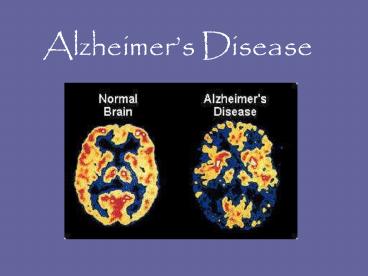Alzheimers Disease - PowerPoint PPT Presentation
1 / 10
Title:
Alzheimers Disease
Description:
Alzheimer's Disease ... Alzheimer's gets worse over time, and it is fatal. ... They contain deposits of a protein fragment called beta-amyloid. ... – PowerPoint PPT presentation
Number of Views:3478
Avg rating:3.0/5.0
Title: Alzheimers Disease
1
Alzheimers Disease
2
- Alzheimers disease is a brain disorder named for
German physician Alois Alzheimer, who first
described it in 1906 after studying the brain of
his patient Auguste D. - More than 5 million Americans now have
Alzheimers disease. - Alzheimers gets worse over time, and it is
fatal. Today it is the seventh-leading cause of
death in the United States. - Is the most common form of dementia.
3
- The brain has 100 billion nerve cells (neurons).
Each nerve cell communicates with many others to
form networks.Nerve cell networks have special
jobs. Some are involved in thinking, learning and
remembering. Others help us see, hear and smell.
Still others tell our muscles when to move. - In Alzheimers disease, parts of the cells
factory stop running well. Scientists are not
sure exactly where the trouble starts. But just
like a real factory, backups and breakdowns in
one system cause problems in other areas. As
damage spreads, cells lose their ability to do
their jobs well. Eventually, they die.
4
- Has no current cure. But treatment for symptoms,
combined with the right services and support, can
make life better for the millions of Americans
living with Alzheimers.
5
Signs Symptoms
- 1. Memory loss.
- 2. Difficulty performing familiar tasks.
- 3. Problems with language.
- 4. Disorientation to time and place.
- 5. Poor or decreased judgment.
6
Signs Symptoms
- 6. Problems with abstract thinking.
- 7. Misplacing things.
- 8. Changes in mood or behavior.
- 9. Changes in personality.
- 10. Loss of initiative.
7
The role of plaques and tanglesTwo abnormal
structures called plaques and tangles are prime
suspects in damaging and killing nerve cells.
Plaques and tangles were among the abnormalities
that Dr. Alois Alzheimer saw in the brain of
Auguste D., although he called them different
names.
8
Scientists are not absolutely sure what role
plaques and tangles play in Alzheimers disease.
Most experts believe they somehow block
communication among nerve cells and disrupt
activities that cells need to survive.
- Tangles form inside dying cells. Though most
people develop some plaques and tangles as they
age, those with Alzheimers tend to develop far
more. The plaques and tangles tend to form in a
predictable pattern, beginning in areas important
in learning and memory and then spreading to
other regions.
- Plaques build up between nerve cells. They
contain deposits of a protein fragment called
beta-amyloid . Tangles are twisted fibers of
another protein called tau .
9
(No Transcript)
10
Alyda Mire
Source Louisiana Department of Health Hospitals































